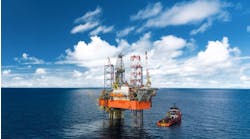Jeremy Beckman
Editor, Europe
Recent surveys on Norway’s E&P future have painted a bleak picture. Statistics provided by the Norwegian Petroleum Directorate identified declines in field investment and productivity last year. NPD is concerned that the slide could continue unchecked, with insufficient new reserves being found, and seeming disinterest in extracting more from mature fields.
There have been disappointing drilling results in high-profile plays, such as Norske Shell’s recent deepwater wells on the Dalsnuten and Gro structures in the Norwegian Sea. But Statoil may have turned the corner with Skrugard, the first potentially major oil find in the Norwegian Barents Sea since Eni’s Goliat. Tim Dodson, executive VP Exploration, said the Skrugard well – 100 km (62 mi) north of the Snohvit gas field – “confirmed that our exploration model is correct. This is a breakthrough and an important step in understanding how the geology – and the hydrocarbon systems in the Barents Sea – works.”
The Gygrid tieback to the Njord A platform is one of several fast-track projects Statoil has committed to. Photo courtesy Øyvind Nesvåg, Statoil.
While some mature fields may be in inexorable decline, others are being revitalized, such as Ekofisk and Eldfisk in the southern Norwegian North Sea. ConocoPhillips has submitted development plans to extract a potential 500 MMboe from these fields at a potential cost of over $10 billion. New hubs are also emerging, including BP’s $6.6-billion Skarv-Idun gas condensate project in the Norwegian Sea, due to start production this summer.
Statoil has launched large-scale platform projects in the North Sea for the Valemon field, south of Gullfaks, and Gudrun, north of Sleipner West. Others are in prospect later this year in the same region for Lundin Petroleum’s Greater Luno Area scheme and Total’s gas condensate field Hild, a potential $3.5-billion development.
For Statoil, speeding up development of small fields by applying standardized subsea hardware is another priority. Over the past year, the company has submitted plans for fasttrack tieback projects for the Fossekall/Dompap, Gamma/Harepus, and Gygrid fields in the Norwegian Sea, and for Visund South, Katla, Vilje South, Visund North, and Snorre B template in the North Sea. The company aims to have five of these fields in operation late 2012-early 2013, and to maintain this rate of new producers over the following years.
In the UK, the long-predicted exodus of the majors has yet to materialize. In fact, they continue to prop up the development sector, particularly in harsher environments. Leading the way is BP, which has ordered a new $1.3-billion FPSO from Hyundai Heavy Industries for the redevelopment of the Schiehallion field West of Shetland, where 25 new wells will be drilled.
In the same region, BP also hopes for sanction from the government for its £4-billion, 638 MMbbl Clair Ridge project which involves adding two bridge-linked platforms on the Clair field. And later this year, Chevron may file a plan for its Lochnagar/Rosebank oil field in 1,100 m (3,609 ft) of water – the deepest yet for a UKCS development – in the Faroe-Shetland Channel. This will likely incorporate an FPSO and high angle/horizontal wells.
One of the last acts of the previous Labour administration was to approve tax relief for HP/HT gas condensate developments. Three have since been put forward, all in the central North Sea: ConocoPhillips’ 1 tcf/131 MMbbl Jasmine, involving three new platforms connected to the Judy production complex; Total’s 85 MMboe West Franklin Phase II, featuring a 12-slot wellhead platform exporting to the Elgin field center; and BP’s $811-million Devenick subsea tieback to Marathon’s East Brae platform.
Independents are leading the way in exploration, with Encore discovering oil in the Catcher, Varadero, and Burgman prospects in central block 28/9. In the northern North Sea, Sterling Resources proved further oil in Cladhan, which could hold in-place reserves of over 300 MMbbl. Among the majors, Shell has not been the most active driller of late on the UK shelf, but a recent re-evaluation of its 1999 Fram discovery has lifted volumes here from 70-75 MMbbl to 300 MMbbl.
Elsewhere in Europe, DONG Energy has submitted a $1.6-billion plan to develop the Hejre oil field, which has some of the most extreme conditions offshore Denmark – arrival pressures up to 835 bar (12,110 psi), temperatures up to 160°C (320°F). Offshore western Ireland, Shell finally has approval to install a pipeline from the 1 tcf Corrib gas field to the shore, after years of delays caused by environmental protests.
In Italy, the government has halted all near-shore drilling in response to the Macondo well blowout. This has caused some operators to postpone shallow-water development projects, although some believes that the recent supply constraints caused by events in North Africa could lead the government to revoke its decision.
In the Baltic Sea, Line 1 of the Nord Stream pipeline taking Russian gas throughout Europe should enter service in the fall, while construction of line 2 should start this month.
Offshore Articles Archives
View Oil and Gas Articles on PennEnergy.com




